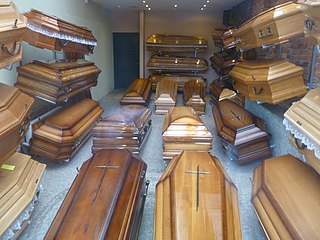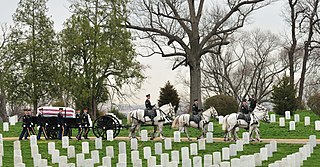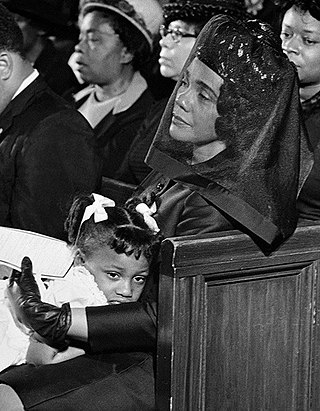
A funeral is a ceremony connected with the final disposition of a corpse, such as a burial or cremation, with the attendant observances. Funerary customs comprise the complex of beliefs and practices used by a culture to remember and respect the dead, from interment, to various monuments, prayers, and rituals undertaken in their honour. Customs vary between cultures and religious groups. Funerals have both normative and legal components. Common secular motivations for funerals include mourning the deceased, celebrating their life, and offering support and sympathy to the bereaved; additionally, funerals may have religious aspects that are intended to help the soul of the deceased reach the afterlife, resurrection or reincarnation.

A hearse is a large vehicle, originally a horse carriage but later with the introduction of motor vehicles, a car, used to carry the body of a deceased person in a coffin at a funeral, wake, or memorial service. They range from deliberately anonymous vehicles to heavily decorated vehicles.

A coffin is a funerary box used for viewing or keeping a corpse, either for burial or cremation.

African art describes the modern and historical paintings, sculptures, installations, and other visual culture from native or indigenous Africans and the African continent. The definition may also include the art of the African diasporas, such as: African-American, Caribbean or art in South American societies inspired by African traditions. Despite this diversity, there are unifying artistic themes present when considering the totality of the visual culture from the continent of Africa.

A military funeral is a memorial or burial rite given by a country's military for a soldier, sailor, marine or airman who died in battle, a veteran, or other prominent military figures or heads of state. A military funeral may feature guards of honor, the firing of volley shots as a salute, drumming and other military elements, with a flag draping over the coffin.

After Abraham Lincoln was assassinated on April 14, 1865, a three-week series of events was held to mourn the death and memorialize the life of the 16th president of the United States. Funeral services, a procession, and a lying in state were first held in Washington, D.C., then a funeral train transported Lincoln's remains 1,654 miles (2,662 km) through seven states for burial in Springfield, Illinois. Never exceeding 20 mph, the train made several stops in principal cities and state capitals for processions, orations, and additional lyings in state. Many Americans viewed the train along the route and participated in associated ceremonies.

The ancient Egyptians had an elaborate set of funerary practices that they believed were necessary to ensure their immortality after death. These rituals included mummifying the body, casting magic spells, and burials with specific grave goods thought to be needed in the afterlife.

Clementine Hunter was a self-taught Black folk artist from the Cane River region of Louisiana, who lived and worked on Melrose Plantation.
Icelandic funerals are ceremonies that are largely shaped by the Evangelical Lutheran Church of Iceland, the largest Christian organisation in Iceland. However, customs may vary depending on religious group.

A funeral train carries a coffin or coffins (caskets) to a place of interment by railway. Funeral trains today are often reserved for leaders, national heroes, or government officials, as part of a state funeral, but in the past were sometimes the chief means of transporting coffins and mourners to graveyards. Many modern era funeral trains are hauled by operationally restored steam locomotives, due to the more romantic image of the steam train against more modern diesel or electric locomotives, although non-steam powered funeral trains have been used.

The funeral of Diana, Princess of Wales, started on Saturday 6 September 1997 at 9:08 am in London, when the tenor bell of Westminster Abbey started tolling to signal the departure of the cortège from Kensington Palace. The coffin was carried from the palace on a gun carriage by riders of the King's Troop and escorted by mounted police along Hyde Park to St James's Palace, where Diana's body had remained for five days before being taken to Kensington Palace. The Union Flag on top of the palace was lowered to half mast. The official ceremony was held at Westminster Abbey in London and finished at the resting place in Althorp.

The Abbey in the Oakwood is an oil painting by the German Romantic artist Caspar David Friedrich. It was painted between 1809 and 1810 in Dresden and was first shown together with the painting The Monk by the Sea in the Prussian Academy of Arts exhibition of 1810. On Friedrich's request The Abbey in the Oakwood was hung beneath The Monk by the Sea. This painting is one of over two dozen of Friedrich's works that include cemeteries or graves.

A funeral procession is a procession, usually in motor vehicles or by foot, from a funeral home or place of worship to the cemetery or crematorium. In earlier times the deceased was typically carried by male family members on a bier or in a coffin to the final resting place. This practice has shifted over time toward transporting the deceased in a hearse, while family and friends follow in their vehicles. The transition from the procession by foot to procession by car can be attributed to two main factors; the switch to burying or cremating the body at locations far from the funeral site and the introduction of motorized vehicles and public transportation making processions by foot through the street no longer practical.

The SCAD Museum of Art was founded in 2002 as part of the Savannah College of Art and Design in Savannah, Georgia, and originally was known as the Earle W. Newton Center for British American Studies.

During the Pre-Hispanic period the early Filipinos believed in a concept of life after death. This belief, which stemmed from indigenous ancestral veneration and was strengthened by strong family and community relations within tribes, prompted the Filipinos to create burial customs to honor the dead through prayers and rituals. Due to different cultures from various regions of the Philippines, many different burial practices have emerged. For example, the Manobos buried their dead in trees, the Ifugaos seated the corpse on a chari before it was brought to a cave and buried elsewhere. The most common forms of traditional burials are supine pits, earthenware jars, and log coffins, and have been a topic of interest among Philippine archaeologists since the early 20th century.

In the United Kingdom, state funerals are usually reserved for monarchs. The most recent was the state funeral of Queen Elizabeth II on 19 September 2022.

The first memorial service following the assassination of Martin Luther King Jr. on April 4, 1968, took place the following day at the R.S. Lewis Funeral Home in Memphis, Tennessee. This was followed by two funeral services on April 9, 1968, in Atlanta, Georgia, the first held for family and close friends at Ebenezer Baptist Church, where King and his father had both served as senior pastors, followed by a three-mile procession to Morehouse College, King's alma mater, for a public service.

Chinese funeral rituals comprise a set of traditions broadly associated with Chinese folk religion, with different rites depending on the age of the deceased, the cause of death, the deceased's marital and social statuses. Different rituals are carried out in different parts of China, many contemporary Chinese people carry out funerals according to various religious faiths such as Buddhism or Christianity. However, in general, the funeral ceremony itself is carried out over seven days, and mourners wear funerary dress according to their relationship to the deceased. Traditionally, white clothing is symbolic of the dead, while red is not usually worn, as it is traditionally the symbolic colour of happiness worn at Chinese weddings. The number three is significant, with many customary gestures being carried out three times.

On 6 February 1952, George VI, King of the United Kingdom, died at the age of 56, at Sandringham House, after battling with a prolonged cancer. His state funeral took place on 15 February 1952. A period of national mourning commenced and his eldest daughter and successor, Queen Elizabeth II was proclaimed the new monarch by the Accession Council. George VI's coffin lay in St Mary Magdalene Church, Sandringham until 11 February when it was carried, in procession, to the nearby Wolferton railway station. The coffin was carried by train to London King's Cross railway station where another formal procession carried it to Westminster Hall where the king lay in state for three days. Some 304,000 people passed through Westminster Hall with queues up to 4 miles (6.4 km) forming.

Funeral of a Mummy on the Nile is an oil on canvas painting by American artist Frederick Arthur Bridgman. It was painted between 1876 and 1877 and is considered his most acclaimed painting. Since 1990, it has been exhibited in Louisville, Kentucky, at the Speed Art Museum.


















